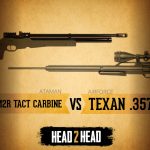I have to admit, as much as we try to go into writing every head to head match up with an unbiased opinion, this one was a little tough. Most of you by now realize that I am a lover of all things big bore air rifle. Coming from a mainly firearms background they really are what drew me into airguns back when I got myself into the hobby. Though I have gained a healthy respect for all airguns, big bores are still my passion and that’s part of what makes this head to head a little different for me. Usually I am pairing up a gun that is well established in the market versus some new comer, but today I am looking at two guns that I have absolutely fallen in love with since they were both released. So with that in mind let’s dive in and take a look at these two competitors, I have a feeling that this bout will be closer than any other we have put together before!
In the red corner, hailing from Mother Russia, weighing in 8.81 lbs, we have a tack driving precision gun with looks to boot. It’s the Ataman M2R Tact Carbine Type 2. With lines reminiscent of the legendary Accuracy International L96 this great looking .357 caliber rifle brings a lot to the table. But, is thE Ataman more than just a pretty face? Let’s meet its competitor and put them both through their paces to find out.
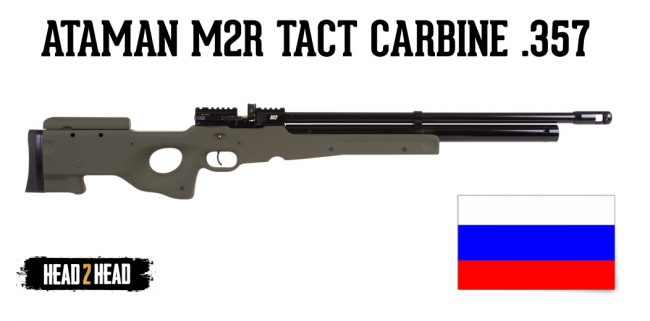
In the blue corner, bearing the name of its home state, weighing in at 7.65 lbs, we have the AirForce Texan .357. This smaller, but not necessarily tamer little brother of the Texan .457 features the same futuristic design and space age construction that we have come to expect from all guns bearing the AirForce name, but can this American classic beat out the competition in its new caliber?
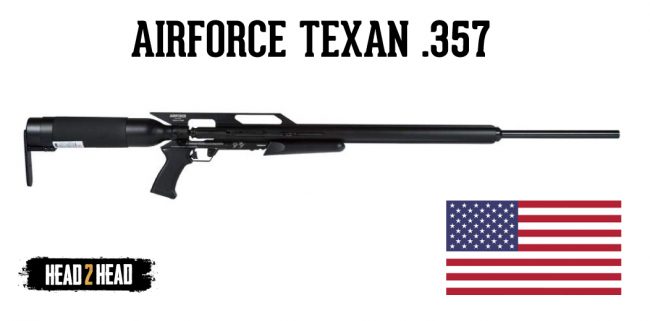
Let’s put them in the ring and find out!
Round 1: Construction and Ergonomics
The first thing that catches your eye on the Ataman air rifle has to be the stock. Ataman makes it no question where they took their design cues from. The Ataman M2R Type 2 is a dead ringer for the L96 precision rifle platform and I have to say, that our exclusive green soft-touch model has to be one of the best looking air rifles that I have ever seen. The stock is actually a hardwood stock that has been sfot touch coated. It definitely has all the heft of a wood stock. The M2R has a very chunky feel in the hand which I like. The generous palm swell and the ambidextrous thumb hole design lend to a very nice grip position. I found the length of pull to be a little on the short side for me, and though the cheek comb is adjustable for height the stock is not adjustable for length of pull. The Atamans metal surfaces are all finished in black anodizing for a tough finish that will hold up to the elements. Note that there is a black soft-touch Ataman M2R Tact Carbine Type 1 air rifle that is more reminiscent of the U.S. Military’s own M40a3 It’s the same rifle, just with that different stock design.
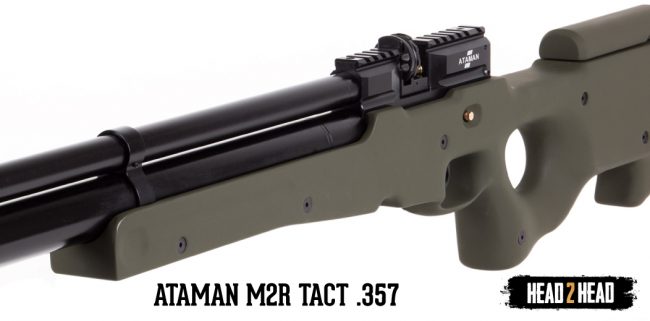
The overall quality of the gun is very high and the individual parts are well thought out. For example, the rotary magazine is all metal and locks up like a well made revolver cylinder. The side lever action is extremely smooth and easy to operate. The magazine well is large enough that single loading larger slugs that will not fit in the rotary magazine is easy without the use of a single shot tray. Simply put, I wish more multi-shot repeaters were designed with the same care. You can tell that the Ataman was built with the shooter in mind.
The AirForce Texan is rock solid when it comes to construction. 100% US made extruded aluminum makes up the frame and integrated scope rail of the rifle. Not only does this provide an extremely durable and rigid frame but it keeps the weight down as well. At the heart of the Texan is its 34’’ inch Lothar Walther cold hammer forged barrel. These barrels arrive straight from Germany at the Air Force manufacturing facility and are inspected before finally machining and assembly to ensure Air Forces strict standard of quality. The frame is anodized black and the barrel is blued to a dark, almost black, blue. The Texan is beautiful in that it is not overly complicated. It’s single shot, breech loading design is easy for anyone to operate and the side lever uses a camming action to make cocking the hammer spring and opening the breech very smooth and fast.
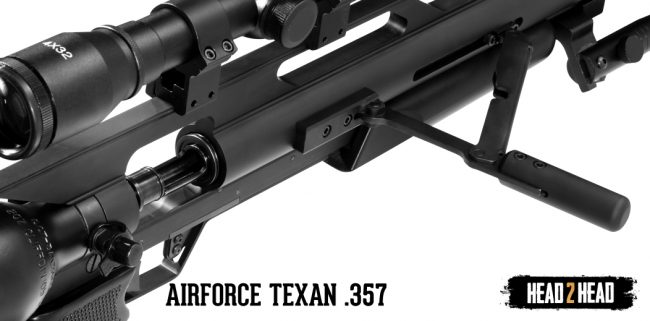
Pulling the Texan to the shoulder the first thing you notice is the different feel of the cheek weld as you are literally resting your cheek on the air tank. While this may take some getting used to, the added pad on the tank makes it comfortable. Because of the tank’s circumference, medium or high rings are best suited to making sure that you have optimal sight alignment with your scope. The Texan does not offer much in the way of adjustability, however, the length of pull is sufficient for most adult shooters to feel comfortable while firing the rifle.
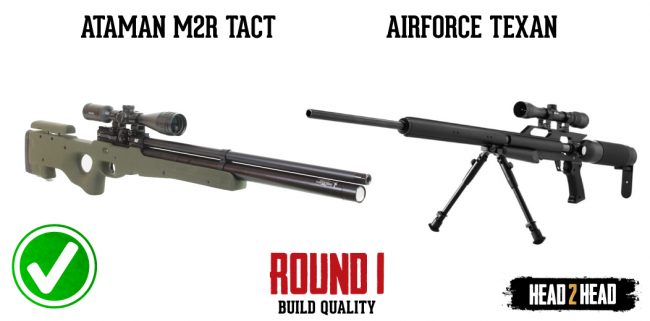
Winner: Though fundamentally different in how they approach things, both of these guns fall squarely into that modern sporting/tactical styling category. That being said they both make excellent transitional platforms for folks who are coming from the firearms crowd and just getting into airguns. As to which one is built better? I really think that the two guns are on par with each other. Both guns are put together really well and I can’t imagine that one would wear out or have problems due to manufacturing. So then it comes down to ergos, which one is more comfortable than the other? If you ask me, again, I would say neither they are both great, but since it’s a competition, I would say that the Ataman with its added adjustability edges out the Texan just barely for this round.
Round 2: Accuracy
For accuracy testing we followed our usual test procedure of firing 5 shot groups at 50 yards on our indoor range. For this test we had 3 varieties of .35 cal ammo on hand. First, we tested the venerable JSB 81.02 grain Diabolo Exacts. The more we have tested JSB pellets the more that they have become our favorite, we have a hard time finding guns that don’t like them. We also had a few of the Nosler/Benjamin collaboration 145 grain eXTREME ballistic tipped bullets. These were developed for use in the Benjamin Bulldog but we have run them in a few other .35’s with good results. Finally, we have a new flavor of bullets, the AeroMagnum 128.5 grain hollow points. These precision airgun bullets are made to exacting standards and are some of the best made ammunition we have encountered to date. (editors note: we’ll be carrying the AeroMagnums soon!)
Both guns were topped off between testing each type of projectile in order to ensure that we were getting peak performance for that group. Each gun was also topped with a scope from Hawke Optics who seems to always deliver a great scope.
Up first was the Ataman using JSB’s. The JSB pellets loaded well in the mag and the 7 shot rotary mag functioned flawlessly with them. I fired off a 5 shot group and wow, right out of the gate the Ataman was shooting lights out with the JSB’s. Shot after shot I could put pellets right where they needed to go. I fired this 3/4 in. center to center group and I was left with a huge smile on my face. This gun does not disappoint. Next up was the AeroMagnums, these were far too long for the rotary mag so they needed to be single loaded, however with the Atamans generous mag well it was not an issue. Firing these pellets it was clear that I had found a shortcoming in the Ataman. It does not like heavy slugs and threw this wide 2 in center to center group. It was not looking good for the Noslers but I tested them anyway and again, a pretty wide group of 2 1/4 in.
Now it was the Texans turn. Once again, the JSB’s were up first. I pushed one into the breach and sighted in on my target. After the first 3 shots I was having deja-vu. The Texan was dropping them right on top of each other. The next two shots went a little wider and I ended up with a 1 3/4 in center to center group. Time for the AeroMagnums. I have to say, I think AeroMagnum and the Texan are a match made in Heaven. First 3 shots were a perfect cloverleaf, all 3 holes touching. The next two shots dropped a little low, I assume due to decreased pressure in the gun. Total center to center measurement was 1 in but the first 3 shots stacked well under that at just over ½ an inch. Last of all was the Noslers. Not a bad little group but certainly not overly impressive.The Nosler group measured out at 1 and 1/2 in. I would recommend these bullets for larger game where the extra weight may be needed but otherwise I would say go with the AeroMagnums.
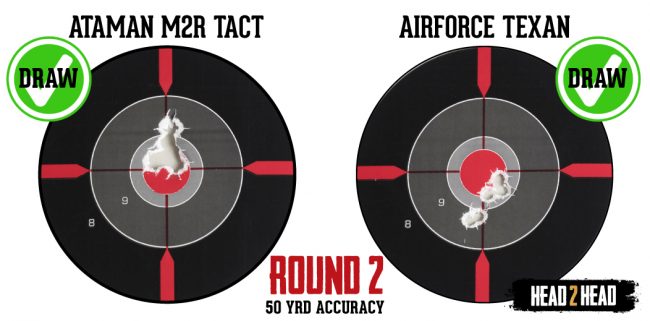
Winner: So who won this round? Both guns did well in some areas and not so hot in others. Well, I decided to call this one a tie and here is why: The Ataman showed phenomenal accuracy with lighter pellets. This reaffirms its stance as a longer range target gun. The Texan shot an awesome group with the heavier pellets, firmly placing the Texan in the hunting category. Each gun does exactly what it’s supposed to when using the correct ammo for the gun, both achieve similar accuracy and that in my eyes make them an even match.
Round 3: Power
Our power test is simple enough, air up the gun, stuff it with ammo, fire 10 shots across the chrony and see who comes out on top. For this test we once again used the JSB’s as well as the AeroMagnums to give a good idea of what each pellet generates ft/lbs wise out of each gun. We omitted the Noslers from the test at this point due to less than stellar performance in both guns.
First up where the JSB’s. The Ataman threw them at an average velocity of 901.4 fps with as standard deviation of just 4.06 fps. That’s good for an average power rating of 146.25 ft/lbs. Very respectable for a gun aimed primarily at target shooters. The Texan, on the other hand, threw the light for caliber JSB’s at an average of 1042.3 fps with a standard deviation of almost 17.5 fps. That gave us an average power rating of 195.54 ft/lbs. I think it’s safe to say that the Texan is running away with this one a bit.
For the sake of thoroughness, we ran the AeroMagnums just the same. The Ataman ran them at an average of 733.02 FPS with a standard deviation of 8.188 fps and an average ft/lbs rating of 153.47 ft/lbs. The Texan sent them down range at an average of 903.46 FPS with a standard deviation of 33.48 fps, that’s good for an average power rating of 233.14 ft/lbs!
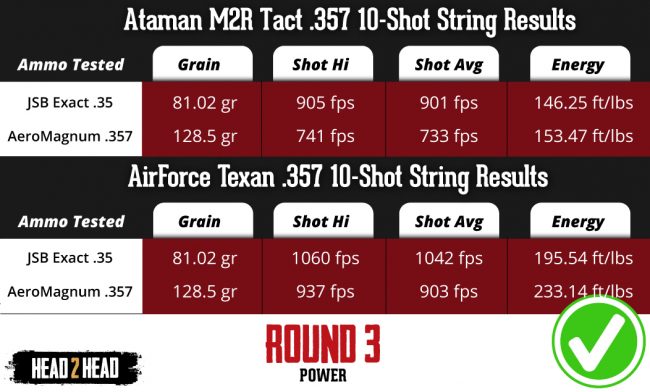
Winner: I think it’s safe to say that the Texan takes this round hands down, but what do you expect from the little brother of the most powerful production air rifle on the market.
Round 4: Triggers
I’m going to get real nit-picky here about something that drives me absolutely nuts about the Ataman. Remember that our Head 2 Head comparisons are always out of the box tests, we do no further set up other than airing the guns up, mounting the scope, and sighting them in. That being said, the Ataman comes with the weirdest factory trigger setup I have ever encountered. And I know it’s not just this gun, it’s every rifle from Ataman I have tested. They come set up with a super light, single stage trigger. It has a long, spongy take-up and then no discernible break whatsoever. You’re just pulling and pulling waiting for the first stage to end and then, BAM!, the gun fires. I really had a hard time getting used to that trigger and though it’s fully user adjustable I have a hard time with the fact that such a pricey air rifle comes with a trigger like that…it boggles the mind.
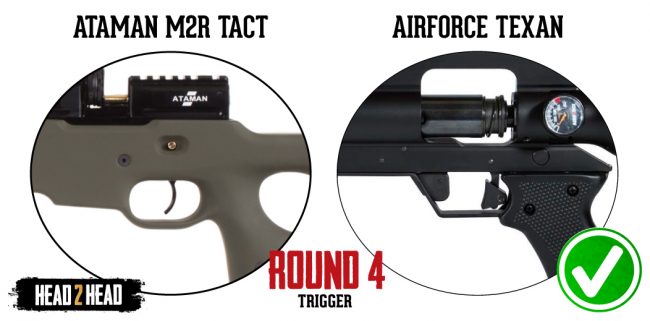
Winner: The Texan though heavier by about 2.5 lbs in pull weight was much more predictable, and though the Texan trigger is not user adjustable, at least you can tell where it’s going to break. This goes to prove that a light trigger pull is not to the only thing that is important. I’m giving this round to the Texan as the two stage trigger, though heavier, was much easier to shoot.
Round 5: Loudness
I’m not going to lie, this round was kind of arbitrary. But I wanted to touch on the noise that these big bore rifles make. Neither of these guns is equipped with any sound dampening technology from the factory and as such both these guns are loud. Though they both technically fall under the 140 dB range that is required to be labeled as “hearing safe” I still like to use a set of foamy earplugs when firing these big bores.
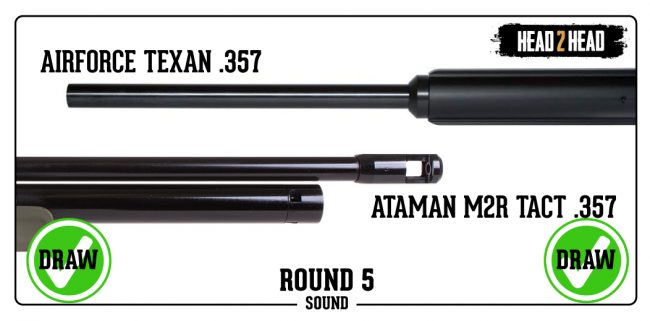
Winner: AirForce did just announce the new suppressed Texan in .45 so maybe a .357 version isn’t far behind. We will have to revisit this part of the fight on a later date, but for now it’s a tie as both of these guns are LOUD!
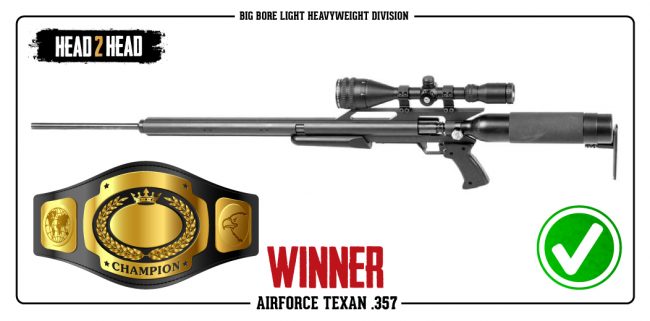
We’ll it looks like the Texan remains our champ for now but only barely. I have to say I think that in some ways these are the closest matched rifles that we have pitted together as of yet. Couple that with the fact that I really… I mean I really like both of these guns. The Ataman is soooo good looking. It just has that added cool factor and on top of that, it shoots lights out with the right pellets. I could shoot through a whole tin of pellets in an afternoon with that gun no problem. It’s that good. On the other hand, the Texan is everything I think a big bore air rifle should be – lightweight, accurate, easy to use, and powerful to boot. The Texan opened up the possibilities of big game hunting with an air rifle to the masses and made something that was once a niche in the sport much more commonplace, and that garners a lot of respect in my book.
I think what it really boils down to is that both these rifles are really good at doing what they were made for and pretty good at a few other things. If you want a tack driving target gun that will punch holes in paper but might be good for dispatching the odd coyote or two, the Ataman is a solid choice. If hunting bigger game is what gets you going then it’s the Texan hands down, but don’t be afraid to take it to the range for a day of fun once in awhile.
